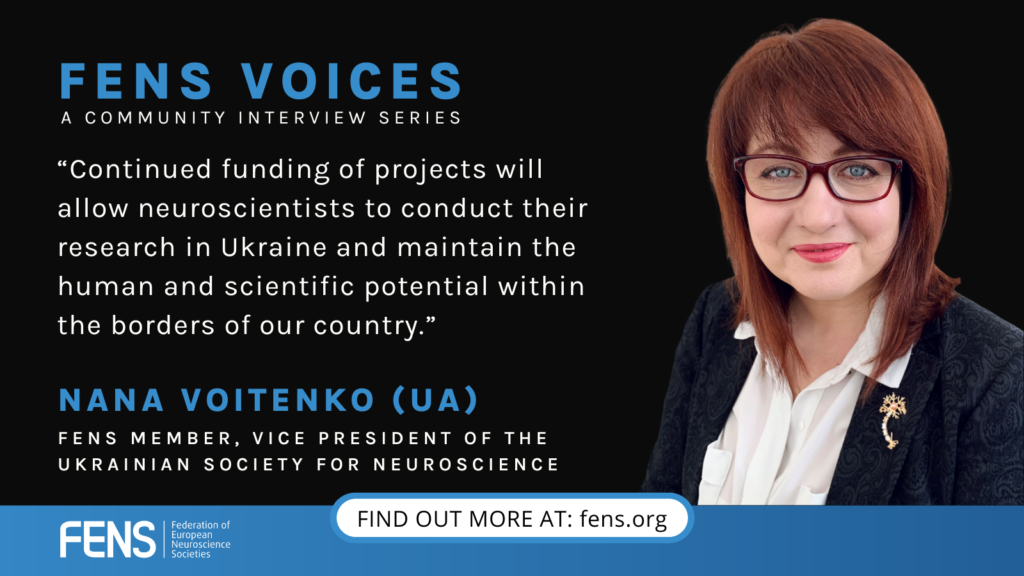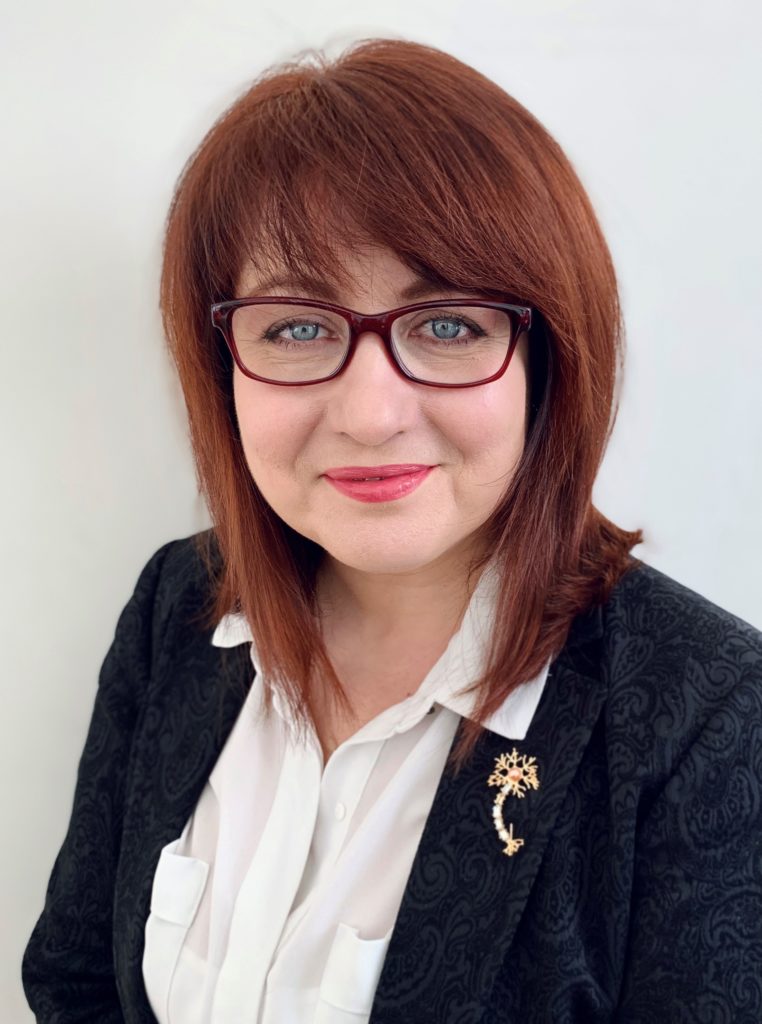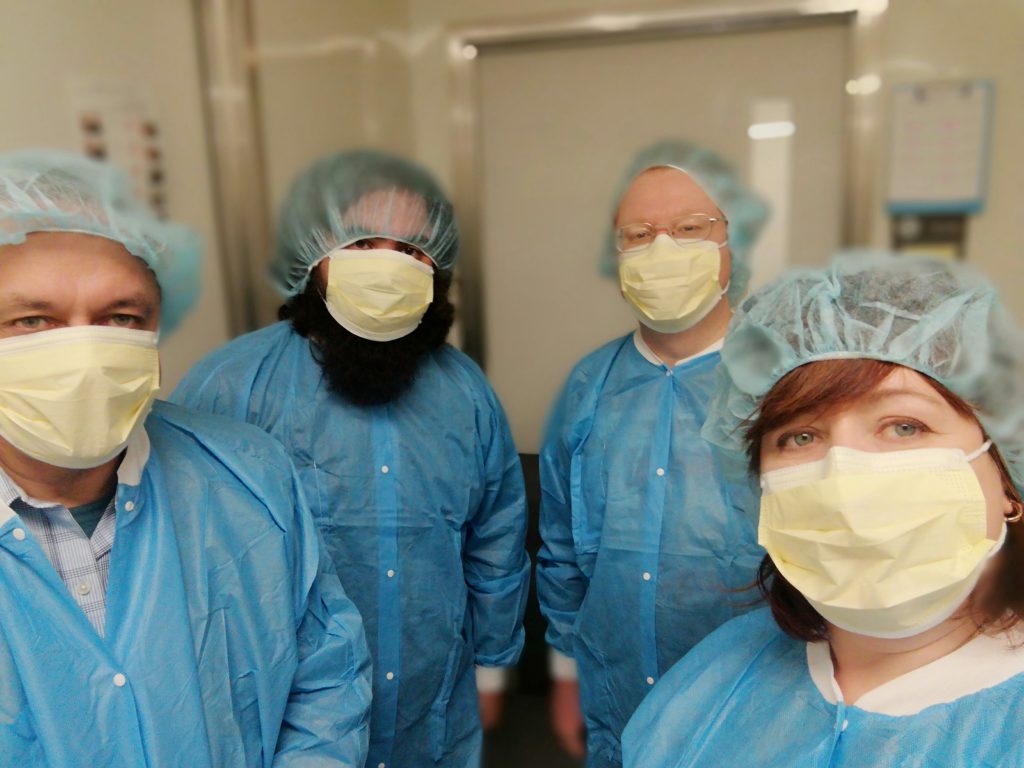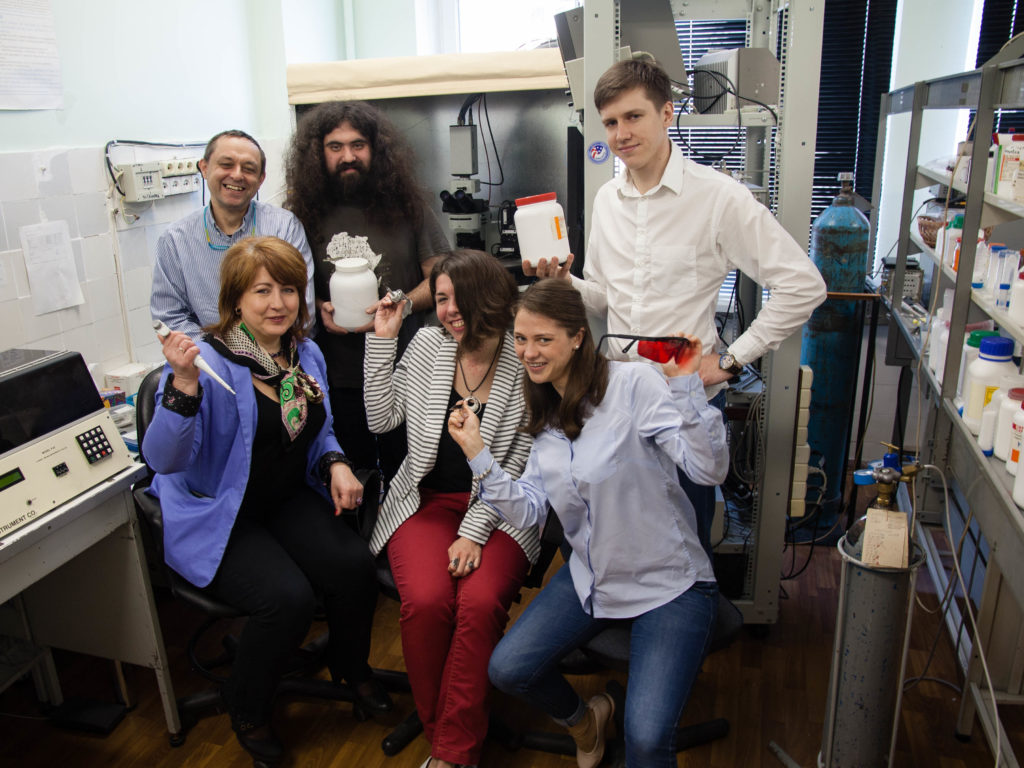
FENS Voices | Nana Voitenko: Neuroscience on the frontline
30 September 2022
FENS News, Neuroscience News
FENS recently had the great pleasure of interviewing FENS member Dr Nana Voitenko, who is founder and Vice President of the Ukrainian Society for Neurosciences and professor of Biomedicine and Neurosciences at the Kyiv Academic University. Her lab team studies the molecular and cellular mechanisms of pain of various origins and her research is currently supported by an NIH RO1 grant. Originally from Baku, Azerbaijan, Dr Voitenko graduated from the Moscow Institute of Physics and Technology and then married and moved to Kyiv when it was still part of the USSR. Facing challenge after challenge, her personal story is an extraordinary, inspiring example of the courage and commitment of all scientists who continue their research with hopeful resolve under the most daunting conditions. Read the full interview below.

Where did you grow up?
NV: I was born and raised in Baku, Azerbaijan. Unfortunately, after graduation it was no longer possible for me to return there, as the First Nagorno-Karabakh War began (the Armenian-Azerbaijani conflict) and my entire family migrated and dispersed around the world. I didn’t have a home to return to in Baku.
You studied Physics in Moscow, after which you have obtained your doctorate degree in Biophysics. How was your experience there and what was your main research focus?
NV: I studied physics at the Moscow Institute of Physics and Technology. During those days, most graduates did not have a wide range of job opportunities. You either worked in one of the institutes of the Academy of Sciences, but this required a Moscow residence permit, or you went to work in the so-called “box” (a classified institute), where you worked for the defense industry. The second option was the most acceptable for non-muscovites, because they were automatically granted a Moscow residence permit and a good salary. To put it shortly, our University was specifically created for the education of high-class specialists and scientists that would later work for the military industry. From the first year of studies, each student received an additional stipendium from the Ministry of Defense. But on a personal level, the latter option did not suit me at all. In the late 80s – early 90s, the iron curtain had already fallen and many scientists were allowed to leave the country for conferences, workshops or internships, on the condition that they did not have a secrecy stamp. And all the employees of the “boxes” had such a status and were not allowed to travel abroad. I always wanted to see the world, I could not imagine myself locked in a cage. So, it was not easy to find a place after graduation. I got married early, as in the USSR it was considered normal to get married at 20. My husband, who was Kyivan, made his choice after graduating from the MIPT and went to Kyiv, where he entered the PhD School of the Ukrainian Academy of Sciences. Fortunately, the MIPT had branches in Kyiv, thus it was possible to carry out research during the last courses of University at one of the institutes of the Ukrainian Academy of Sciences. Back then, Ukraine and Russia were still one country: the USSR (although its collapse was being felt already).
What attracted you to the field of neuroscience?
NV: My master’s degree diploma was devoted to the study of calcium signalling in sensory neurons and my knowledge of physics and mathematics during my studies in Moscow proved to be very useful. In fact, we studied living objects through physical methods: electrophysiology and digital imaging. After receiving my master’s degree, I entered the MIPT PhD School, but I continued my research in Kyiv. Thus, in 1990, I was lucky to find myself in the laboratory of Platon Kostyuk, a famous neurophysiologist, Chair of Biophysics at the Kyiv Branch of the MIPT. Academician Kostuyk was also the Director of the Bogomoletz Institute of Physiology and the Head of the Department of General Physiology of the Nervous System. So, I decided to abandon physics for neuroscience research. It turned out to be one of the best decisions of my life. My PhD thesis was devoted to the study of the molecular mechanisms of calcium signalling in cerebellar neurons and their changes during ontogenesis and ageing. We discovered several interesting patterns of Ca2+ regulation in ageing, which I also noticed in my subsequent works related to various pathologies, such as diabetes. Now I understand that ageing is a kind of programmed pathology.
At that time, during the early 1990s, there was already an active brain drain in this department, but there were still several groups of very active young scientists. I got into the group of Alex Verkhratsky, who worked with Sergey Kirishchuk, Anatoly Shmigol, Alex Savchenko and Nina Pinchuk. All were highly motivated scientists and looked celestial in my eyes. They taught me very complex techniques, such as patch-clamp, calcium imaging and nerve cell culture. We assembled combined patch-clamp and calcium imaging setups ourselves, and developed new protocols. We investigated the processes of regulation of the universal mediator, Calcium, in nerve cells, we also observed how living neurons communicate with each other and with other members of the “brain community”, the glial cells. We also studied how nerve cells aged and died. All of this gave the impression that you were discovering a very important secret.
After the collapse of the Soviet Union, former Soviet and now Ukrainian scientists were given the possibility to move freely around the world. Thus, we went to conferences, workshops and internships. We shared knowledge, observing with great surprise and pleasure that our research was done at the highest level. We were able to observe that our projects proved to be important for the world’s scientific community. It was inspiring. All this together made me fall in love with neuroscience forever. In 1992, I took Ukrainian citizenship and ever since then I have been constantly living in Kyiv, with some breaks dedicated to internships and fellowships.
What were the challenges and opportunities in setting up your own lab in Ukraine?
NV: I defended my PhD thesis in 1995. By that time, all my colleagues had left to work in different laboratories in the UK, Germany, Canada and the USA. I became a “senior” in our group. On the one hand, I understood that I also needed to look for a postdoc position in the West. On the other hand, many opportunities opened up in Ukraine at that time. In 1994 I received a grant from the Soros Foundation, then in 1996 a three-month internship at the Max-Delbruk Center for Molecular Medicine (DE), in Prof. Helmut Kettenmann’s lab.
In 1996, I submitted a project to an open call of the US Civilian Research and Development Foundation. According to the conditions, we had to find an American partner for our project. Platon Kostyuk had once introduced me to Prof. Bertil Hille – the legend of electrophysiology – and I turned to him, asking if he would be interested in a collaboration. To my surprise, he agreed. I won the grant, afterwards another one, and then for many years Bertil was my mentor. He taught me a lot about project management, people and scientific data, lessons that were not taught at the university. It was that invaluable experience that helped me eventually organise my laboratory.
In 1997-98 I worked in the laboratory of Dr Randich at Iowa State University (USA), an experience that gave me the opportunity to expand the methodological approaches of my laboratory. This allowed me to live and work in the USA. My family life did not work out and I got divorced, but Dr Randic was very interested in me staying in her laboratory. I felt responsible towards my staff and students who were staying back in Kyiv. In addition, the grant that we obtained from CRDF forced the project to be carried out in Kyiv. Thus, I returned to Ukraine. In 1999 I received my first independent grant from the Juvenile Diabetes Research Foundation. This allowed me to buy state-of-the-art equipment. I consider the year 1999 to be the birth year of my independent laboratory. Early career scientists, students and graduate students joined me. It was a very productive time back then. I can attribute the success of the laboratory to the fact that the grants allowed me not only to offer decent salaries to employees, but also to purchase modern equipment and all of the necessary reagents. Young people can only be captivated by interesting projects. Otherwise, they get bored and leave.

Has there been sufficient public, private and policymaking support and awareness about brain-related research in Ukraine?
NV: At that time, the Bogomoletz Institute of Physiology was the most famous institute that focused on neuroscience research within the Soviet Union. In Ukraine, it was unique. However, there was no special support. The lack of funding became critical when, in the mid-2000s, targeted support for research in the post-Soviet countries by Western granting bodies ceased, and adequate domestic support did not arise in Ukraine. Competing for Western grants became more and more difficult. No matter how successful an individual laboratory is, it depends on the entire maintenance of the infrastructure: buildings, supplies necessary for research, laboratory animals, etc. All this gradually fell into decay due to the chronic underfunding of science in Ukraine. I have taken part in almost all SfN Meetings since 1997, and since 2002 in almost all FENS Forums. Due to this, I realised that in addition to the need of disseminating scientific data among peers, there is an urgent need for communication and advocacy of neuroscience among decision-makers.
Since 2008, I have started an annual Brain Awareness Week in Ukraine. We organise lectures for school children and roundtables for the public and journalists. We invite media and politicians to our events to communicate the needs of neuroscience research within Ukraine. In 2017, the Ukrainian National Council on Science and Technology Development was founded in accordance with the new law on science, serving under the Cabinet of Ministers. I was elected as one of the 24 members of the Scientific Committee of this Council. One of the main tasks of the Committee was the creation of the independent National Research Foundation of Ukraine. With the support of parliament members and members of the government, we managed to launch NRFU. For the first time in history, Ukraine had a mechanism focused on independent reviews of scientific projects with the substantial involvement of international experts. In 2020, the first calls were held and the best projects received decent funding, at the level of about EUR 100.000 per year. Several projects from the field of neuroscience also benefited from funding.
There is another example of support for brain research in Ukraine that is relevant to policymaking. In 2015, Ukraine became fully associated with Horizon 2020, as hundreds of Ukrainian entities received EU funding until this moment. In 2019, my partners from leading laboratories in Europe and I wrote and won a grant from the Horizon 2020 program – “Neurotwin“, which was dedicated to re-establishing the Bogomoletz Institute of Physiology as an international centre for excellence in Cellular and Molecular Neuroscience. Unfortunately, the pandemic and then the war, as well as outdated bureaucratic regulations, prevented our plans from being completely realised.
How are scientists coping, given the COVID-19 pandemic and the recent military conflict with Russia? Is any research being conducted or has it had to stop entirely?
NV: Our country is going through difficult times. Both the pandemic and, especially, the unexpected attack on us by our northern neighbour caused substantial damage to both Ukrainian science and to the country as a whole.
The pandemic period was especially difficult for us, as our work gravitates on conducting experiments. But my laboratory did not close, as we continued our research (now I am focused on studies of chronic pain mechanisms). The pandemic has raised new questions, in particular, related to post-COVID pain, and the influence of the immune system over the mechanisms of chronic pain. I believe that my colleagues and I will be able to properly address these questions. Of course, our research was significantly slowed down by lockdowns, but it did not stop. We used those periods of forced pauses to analyse the data that we accumulated, to write papers and new grant applications. Our laboratory was helped to survive through a five-year grant from the US National Institutes of Health, which we received in collaboration with Prof. Usachev’s laboratory from the University of Iowa and Prof. Pavel Belan from Bogomoletz Institute of Physiology in 2019.
The war also suspended our research. The activity in the laboratory was suspended for two months, as some areas of Kyiv were under occupation. My colleagues and I went to western Ukraine, as it became very dangerous to stay in Kyiv. When the Kyiv region was liberated, almost the entire laboratory staff returned to the capital and continued their research. Fortunately, the buildings of the Institute were not damaged. I would like to take this opportunity to share with you the amazing deeds of the Director of our animal clinic, Mr Andrey Khomyak. From the first day of war until the liberation of Kyiv, he alone, every day under shelling, on a bicycle came to the Institute to feed and care for the laboratory animals! Other clinic staff could not get to work, as transport did not work. Thanks to Andrey, our animals were saved and we can continue our research.
Another problem that we have faced because of the war is the reduction in funding. Unfortunately, with the beginning of the war, the entire budget of the NRFU was transferred to the needs of the Armed Forces of Ukraine. Undoubtedly, this was a necessary step, which, however, led to a halt in two projects in the lab.
What are the top needs and priorities of the Ukrainian neuroscience community right now and how can FENS or other scientific organisations and individuals help?
NV: At the initial stage of the war, it was very important that those Ukrainian scientists who fled the horrors and atrocities of the Russian invaders and ended up in European countries found work and temporary shelter. Many universities opened their doors to Ukrainian scientists and students. This was a huge help for the refugees, including neuroscientists. However, most Ukrainian scientists do not want to leave the country. In addition, according to martial law, men between the ages of 18 and 60 are prohibited from leaving Ukraine. It is also very important to realise that in the future, after the victory, those who left may decide to permanently stay abroad, which will lead to a significant “brain drain”.
Therefore, I believe that it is very important to help those laboratories which now continue their cutting-edge neuroscience research in Ukraine. Despite the war, most of the labs in Kyiv and in the western part of the country have already resumed their work. However, the suspension of funding does not allow the continuation of research and does not support reasonable wages. As I already said, with the outbreak of the war, the entire budget of the NRFU, the main organisation that finances scientific projects based on international expertise, was transferred to the needs of our army. As a result, 14 projects related to neuroscience were halted at various stages of their implementation. In this situation, the Federation of European Neuroscience Societies (FENS) could help find sources of financial assistance for the NRFU, that would support the above-mentioned research projects. In this way, the best projects and research groups working in the field of neuroscience in Ukraine will be supported, lab members will be paid decent wages, brain drain will be kept to a minimum, and existing research teams will be retained.
I think that continued funding of these projects will allow Ukrainian neuroscientists to conduct their research in Ukraine and maintain the human and scientific potential within the borders of our country. This aid scheme seems feasible for two reasons:
- The above projects have passed international expertise and have approved reasonable budgets.
- NRFU constantly monitors the readiness of laboratories for the implementation of projects and has all the data on whether each specific laboratory has been destroyed physically and/or suffers or not in terms of human resources.
The other possibility is a prompt introduction of new types of calls within Horizon Europe to specifically support both individual and European collaborative research in Ukrainian institutions (as it was during the 1990s for post-soviet countries). Such targeted assistance will effectively help Ukrainian neuroscience survive the war and recover faster after our common victory.

FENS community support for Ukraine
The Federation of European Neuroscience Societies (FENS) stands in solidarity with the scientific community and all those who are suffering directly or indirectly from the attack on Ukraine. Our membership aims to empower scientists and advance brain research and education across Europe and beyond under the safest and most supportive conditions. Current hostilities are threatening this mission, the welfare of our members and the broader global society. As the voice of European neuroscience, FENS firmly opposes the invasion of Ukraine and expresses its support to our Ukrainian family, friends, neighbours and colleagues, as well as to the scientists and citizens in Russia who courageously oppose this war. We hope that a peaceful resolution can be achieved as rapidly as possible. In an effort to help the affected scientists, FENS has reached out to the neuroscience community to share resources and opportunities to support those affected by the conflict presented below. New resources will be added as they become available.
About Nana Voitenko
Nana Voitenko received her PhD at Bogomoletz Institute of Physiology (BIPH), Kyiv, Ukraine, in 1995, after which she completed an internship at the Max Delbrück Centre for Molecular Medicine. She then joined the Department of Biomedical Sciences at Iowa State University (Ames, USA) as a postdoctoral fellow. There she studied the role of dorsal horn spinal cord glutamate receptors in pain signalling. In the early 2000s, she returned to Kyiv with a grant from the Juvenile Diabetes Research Foundation, which allowed her to start her current lab at BIPH. Her team studies the molecular and cellular mechanisms of pain of various origins and her research is currently supported by an NIH RO1 grant. In 2011, she became Head of the Laboratory and in 2017 Head of the Department of Sensory Signalling at BIPH. She also served as Deputy Director of BIPH from 2011 to 2016. She was awarded the State Prize of Ukraine in the field of science and technology in 2013 and won the Horizon2020 NEUROTWIN grant as a coordinator in 2019. Since 2008, she is a professor of Biomedicine and Neurosciences at the Kyiv Academic University. She now leads Dobrobut Academy, a newly-established private, non-profit medical school. Nana Voitenko is the founder and Vice President of the Ukrainian Society for Neurosciences, often serving as the society’s representative on the FENS Governing Council.
About the Ukrainian Society for Neuroscience
The Ukrainian Society for Neuroscience (USN) is a non-governmental, voluntary and self-governing social and scientific organisation of Ukrainian citizens, who are employed at scientific and/or teaching jobs in the area of neuroscience. The society was founded in 1998 and currently has more than 100 members. USN is a member of the Federation of European Neuroscience Societies. The main goal of society is the consolidation of the efforts of scientists for solving fundamental and applied scientific problems in different branches of neuroscience.
About the Federation of European Neuroscience Societies (FENS)
Founded in 1998, the Federation of European Neuroscience Societies is the main organisation for neuroscience in Europe. It currently represents 44 national and single-discipline neuroscience societies across 33 European countries and more than 22,000 member scientists. Discover FENS and subscribe to our biweekly News Alert, with information on our latest calls and activities.